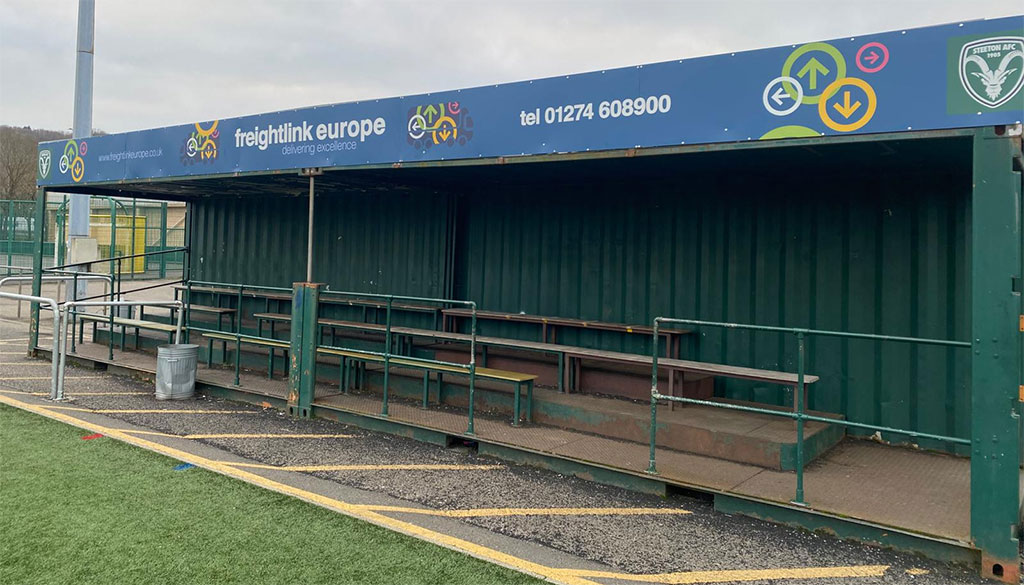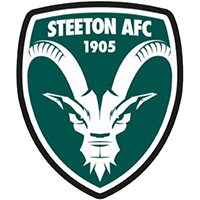
Emblematically Speaking - Steeton
Tue 20th November 2018 | Steeton | By Stewart Taylor
Many followers of the Hallmark Security League will be very familiar with Silsden AFC and may well have travelled via Steeton and Silsden railway station when visiting the ground. Perhaps less familiar to us are their neighbours Steeton AFC.
That the two towns share a railway station is not the only connection as Steeton AFC are currently playing their home matches at Keighley Cougars Rugby League ground which, as many will remember, hosted Silsden AFC matches during their early years in the League.
Shared history up to a point, but if we go back in time Steeton has a fascinating history which, as with many towns across England, focuses on prominent families and their role as Lords of the Manor.
Not the first Lords of the Manor by any means, but in the early part of the 17th century much of the land of Steeton, including Steeton Hall, was sold to the Garforth family.
However, in accordance with the general principles of the time, the Garforths had lived at the manor but as tenants rather than owners for many years previously. Records show that the Garforth family lived at the manor until the early part of the 19th century.
As with many important families, the Garforths have some claims to fame and influence during their tenure of the manor of Steeton. One of the earliest recorded is Richard Garforth, a soldier who was at the Battle of Flodden Field in 1513.
It is recorded that he went “with horse and harness” which is taken to mean that he was a man of some means. Many Garforths came and went until we reach John Baynes Garforth (son of Elizabeth, daughter of Edmund Garforth) who succeeded to the estates of Edward Garforth. John was Member of Parliament for a number of constituencies between 1780 and 1802.
All well and good you may say, but what has this to do with the emblem of Steeton AFC?
The answer to that question comes in the shape of a goat’s head on a green background which is the striking emblem of Steeton AFC. The green background reflects the club’s playing colours, but it is the goat’s head which links everything together.
The goat’s head is taken from the crest of the Garforth family and this acts as a constant reminder of one of the significant families of the town.
But that’s not the only connection. Those who know me well are aware that beer and pubs feature largely on my list of interests.
The presence of the Goat’s Head pub on Skipton Road in Steeton allows me to wander off briefly in that direction. This impressive roadside pub can trace its history back over two centuries, but it is not the original pub of that name in the town.
The original Goat’s Head pub was built by Edmund and Elizabeth Garforth (yes, the Garforths again) in 1710 but was closed in 1794. The building still exists as Inglenook Cottage on Upper School Street and is Grade II listed.
It is entirely possible that the current pub of that name, which has a strong community focus, was built in 1794 as a direct replacement.
Here we see that the emblem of a local football club links both an important family of the town and a pub, each of which either serve or have served the town in the most positive of ways. Cheers!
 Emblematically Speaking - Steeton
Emblematically Speaking - Steeton
Tue 20th November 2018 | Steeton
By Stewart Taylor

Many followers of the Hallmark Security League will be very familiar with Silsden AFC and may well have travelled via Steeton and Silsden railway station when visiting the ground. Perhaps less familiar to us are their neighbours Steeton AFC.
That the two towns share a railway station is not the only connection as Steeton AFC are currently playing their home matches at Keighley Cougars Rugby League ground which, as many will remember, hosted Silsden AFC matches during their early years in the League.
Shared history up to a point, but if we go back in time Steeton has a fascinating history which, as with many towns across England, focuses on prominent families and their role as Lords of the Manor.
Not the first Lords of the Manor by any means, but in the early part of the 17th century much of the land of Steeton, including Steeton Hall, was sold to the Garforth family.
However, in accordance with the general principles of the time, the Garforths had lived at the manor but as tenants rather than owners for many years previously. Records show that the Garforth family lived at the manor until the early part of the 19th century.
As with many important families, the Garforths have some claims to fame and influence during their tenure of the manor of Steeton. One of the earliest recorded is Richard Garforth, a soldier who was at the Battle of Flodden Field in 1513.
It is recorded that he went “with horse and harness” which is taken to mean that he was a man of some means. Many Garforths came and went until we reach John Baynes Garforth (son of Elizabeth, daughter of Edmund Garforth) who succeeded to the estates of Edward Garforth. John was Member of Parliament for a number of constituencies between 1780 and 1802.
All well and good you may say, but what has this to do with the emblem of Steeton AFC?
The answer to that question comes in the shape of a goat’s head on a green background which is the striking emblem of Steeton AFC. The green background reflects the club’s playing colours, but it is the goat’s head which links everything together.
The goat’s head is taken from the crest of the Garforth family and this acts as a constant reminder of one of the significant families of the town.
But that’s not the only connection. Those who know me well are aware that beer and pubs feature largely on my list of interests.
The presence of the Goat’s Head pub on Skipton Road in Steeton allows me to wander off briefly in that direction. This impressive roadside pub can trace its history back over two centuries, but it is not the original pub of that name in the town.
The original Goat’s Head pub was built by Edmund and Elizabeth Garforth (yes, the Garforths again) in 1710 but was closed in 1794. The building still exists as Inglenook Cottage on Upper School Street and is Grade II listed.
It is entirely possible that the current pub of that name, which has a strong community focus, was built in 1794 as a direct replacement.
Here we see that the emblem of a local football club links both an important family of the town and a pub, each of which either serve or have served the town in the most positive of ways. Cheers!


